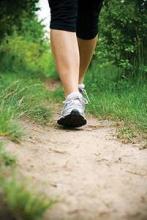A short, brisk walk can reduce the urge to drink alcohol among heavy drinkers, a group of researchers has found.
The results of the study mirror findings from research showing that moderate exercise can reduce signals of food and cigarette cravings. However, this was the first study to report that a single session of moderate exercise can significantly reduce attentional bias toward alcohol-related images as well as self-reported cravings (Ment. Health Phys. Act. 2013 Sept. 20 [doi: 10.1016/j.mhpa.2013.09.004]). A previous study in diagnosed alcoholics found that alcohol cravings were reduced during a brief period of exercise but not after it (Addict. 2004;99:1542-7).
Attentional bias, the tendency to focus on emotionally dominant stimuli, is an important measure used in studies of cravings, as it relies not on self-reporting but on visual attention paid to images presented by investigators. In the current study, led by Adrian H. Taylor, Ph.D., of the University of Exeter, in Devon, England, investigators measured two types of attentional bias – initial and maintained – related to alcohol imagery. The latter was found to be significantly reduced in the group that had exercised, compared with the controls. Self-reported cravings also were shown to be reduced.
For their research, Dr. Taylor and his colleagues recruited 20 healthy volunteers (mean age, 20.8 years; 11 women) who were not alcoholics seeking treatment but who self-reported drinking heavily. The women reported drinking 14 units of alcohol or more per week, and the men reported drinking 21 units or more per week.
Subjects were randomly assigned either to 15 minutes of sitting without access to reading materials or other stimuli or to 15 minutes of moderate walking on a treadmill. Before and after the period of sitting or walking, participants completed a task that matched neutral and alcohol images randomly presented for either 200 ms to measure initial attentional bias (IAB) or 1 second to measure maintained attentional bias (MAB). A standardized Alcohol Urge Questionnaire also was administered before, and three times after, the period of sitting or walking to collect information on self-reported cravings.
The study’s results showed that MAB was significantly reduced after exercise, compared with the control condition (P = .058).
The mechanisms mediating the effect of exercise on alcohol urges during exercise are unclear, Dr. Taylor and his colleagues said. Drinking alcohol regulates moods and reduces negative feelings. Perhaps exercise also enhances "affect and mood in a way that reduces drinking urges and salience of alcohol as a source of pleasure and reward." Animal research has suggested that numerous neurobiological mechanisms are implicated in drug use and might be modifiable by exercise, "including dopamine, glutamate, norepinephrine, opioids, PKA [protein kinase A], extracellular signal-related kinase, and brain-derived neurotropic factor," they wrote.
However, the investigators also acknowledged that they could not exclude the possibility that the effect seen in the intervention group was tied to distraction rather than physical activity. Future studies, they said, should include a third arm of subjects who would be allowed to watch television or participate in other distracting activity prior to being tested. Another limitation cited by the investigators was the fact that participants were not clinically diagnosed as alcoholics but self-reported as heavy drinkers.
Further research is needed to determine whether short bursts of exercise could help reduce alcohol cravings in people prone to them, the authors wrote. However, they said, the findings had some immediate implications for practice: "A short, brisk walk may be an attractive self-help strategy to manage cravings and provide immediate relief for those experiencing alcohol urges."
The authors received no external funding, and neither Dr. Taylor nor his coauthors had conflicts of interest.


